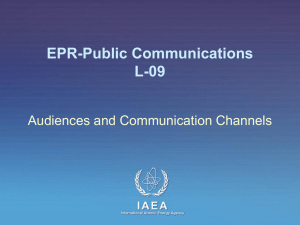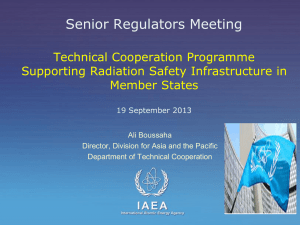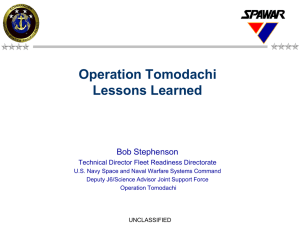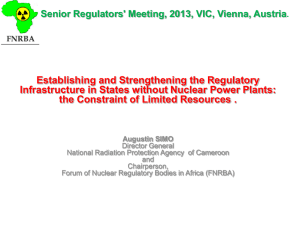Radiation
advertisement
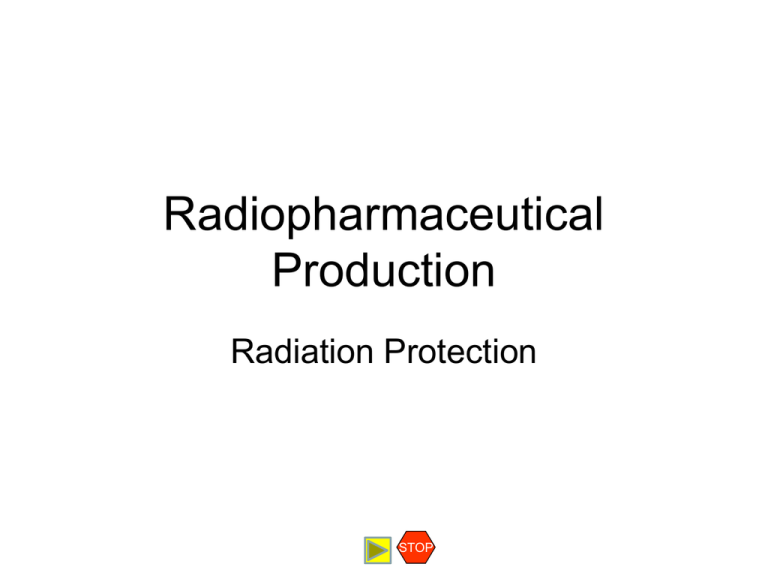
Radiopharmaceutical Production Radiation Protection STOP Table of Contents • • • Radiation protection involves a philosophy of trying to keep personnel dose as low as reasonable achievable (ALARA) This philosophy is carried out through a radiation protection program that involves evaluating hazards, trying mitigate those hazards which pose a significant threat if no action is taken, and learning from past experience and incorporating these past lessons into current practices. A series published by the IAEA incorporates these principles into a set of guidelines and guidance documents Contents • Basic Principles • Recommended Dose Limits • Work Flow Diagram • Protective Clothing • Area Monitoring • Air monitoring • Shielding • Training • IAEA Guidelines • IAEA Guidance Documents STOP Basic Principles Radiopharmaceutical Production Radiation Protection Contents Basic Principles Recommended Dose Limits Work Flow Diagram Protective Clothing Area Monitoring Air monitoring Shielding Training IAEA Guidelines IAEA Guidance Documents • • • The first step in the development of a radiation protection program is an evaluation of all the situations where there is a potential for radiation exposure. The level of effort, formality, and detail of the radiation protection program must be linked to the magnitude of both the routine and accidental exposures, and to the probabilities of these exposures. This preliminary radiological evaluation should cover all aspects of operations and should include: – An identification of the sources of routine and reasonably foreseeable potential exposures. – A realistic estimate of the relevant doses and probabilities. – Assessment of safety. – Licensing process. STOP Types of Controls Radiopharmaceutical Production Radiation Protection Contents Basic Principles Recommended Dose Limits Work Flow Diagram Protective Clothing Area Monitoring Air monitoring Shielding Training IAEA Guidelines IAEA Guidance Documents STOP Once the hazards have been evaluated, controls are used to protect personnel and the general public from exposure to radiation hazards. The design of an effective safety program incorporates a combination of: • Engineered controls; • Administrative controls; and • Personal protective equipment, e.g. protective clothing, shoe covers, etc. Examples of Engineering Controls Examples of Administrative Controls Shielding of the sources Interlocks on operation of radiation producing devices when trying to access these areas Using sealed enclosures to reduce exposure or contamination Remove the worker from the job if their dose is near the limits set for the job Minimize exposure times by work planning Use radionuclides only in designated areas using safe handling techniques Limit personnel access to radiological areas Manager Responsibilities Radiopharmaceutical Production Radiation Protection Contents Basic Principles Recommended Dose Limits Work Flow Diagram Protective Clothing Area Monitoring Air monitoring Shielding Training IAEA Guidelines IAEA Guidance Documents STOP Managers have certain responsibilities concerning radiation protection in their facilities, including: • Establishing high standards for the performance of radiation safety. • Providing the tools to achieve effective radiation protection. • Holding workers and their supervisors accountable for radiation safety. • Ensuring an open environment that encourages respect for the radiological requirements of the RSM. • Resolving issues that inhibit performance of radiation safety. Worker Responsibilities Radiopharmaceutical Production Radiation Protection Contents Basic Principles Recommended Dose Limits Work Flow Diagram Protective Clothing Area Monitoring Air monitoring Shielding Training IAEA Guidelines IAEA Guidance Documents STOP Workers also have certain responsibilities with respect to working with radiation. All personnel subject to these requirements should: • Follow any applicable rules and procedures for protection and safety specified by the facility. • Use the monitoring devices and the proper personal protective equipment provided. • Cooperate with the radiation safety personnel with respect to protection and safety, the operation of radiological health surveillance, and dose assessment programs. • Abstain from any willful action that could put themselves or others in situations that violate the requirements. • Comply with all radiological postings encountered in the work place. • Maintain training qualifications necessary to conduct assigned radiological work. • Immediately report all radiological incidents that occur in the work place to their supervisor. • Ask questions if you are uncertain of the radiological requirements for their work. Recommended Dose Limits Radiopharmaceutical Production Radiation Protection Contents Basic Principles Recommended Dose Limits Work Flow Diagram Protective Clothing Area Monitoring Air monitoring Shielding Training IAEA Guidelines IAEA Guidance Documents STOP Dose limits for radiological workers and the public are provided in the following Table. It should be noted that these limits are subject to jurisdictional control, and it is the responsibility of the user to be informed as to the limits set by his institution and/or government agency Type of Exposure SI units (per year) Radiological worker: effective dose (internal + external), averaged over 5 years* 20 mSv Radiological worker: equivalent dose to lens of eye 150 mSv Radiological worker: equivalent dose to extremity (hands and arms below the elbow, feet and legs below the knees) and skin 500 mSv Visitors and public: effective dose (internal + external) 1 mSv Work Flow Diagram Radiopharmaceutical Production Radiation Protection Contents Basic Principles Recommended Dose Limits Work Flow Diagram Protective Clothing Area Monitoring Air monitoring Shielding Training IAEA Guidelines IAEA Guidance Documents A key part of planning is to learn from the planning that has been done previously. The feedback from the worker and any unsafe conditions encountered while doing the work should be discussed and written up, so that they can serve as a resource to future work planning. A flow chart for overall work planning is shown in the figure C o n ceive exp erim en t o r fa cility w o rk C o n du ct a review o f all h azard s asso ciated w ith th e w o rk A re th ere rad io lo gical h azard s? Y es C o n du ct an A L A R A revie w P rep are techn ical w o rk d o cu m en ts P erfo rm W o rk STOP No E valu ate th e w o rk an d im p ro ve th e m eth o d s Protective Clothing Radiopharmaceutical Production Radiation Protection Contents Basic Principles Recommended Dose Limits Work Flow Diagram Protective Clothing Area Monitoring Air monitoring Shielding Training IAEA Guidelines IAEA Guidance Documents STOP • • • Protective clothing designated for radiological control use should be specifically identified by colour, symbol, or appropriate labeling; and should not be used for nonradiological work. Personal protective equipment and clothing should not be stored with personal street clothing. An example of a person ready for radiological work is shown in the figure. He is wearing a colour coded labcoat, gloves and gauntlets, safety glasses and his TLD on the outside of his coat. Area Monitoring Radiopharmaceutical Production Radiation Protection Contents Basic Principles Recommended Dose Limits Work Flow Diagram Protective Clothing Area Monitoring Air monitoring Shielding Training IAEA Guidelines IAEA Guidance Documents STOP • The areas around the workplace should be monitored at all times to be sure the levels in the room do not rise due to a leak or loss of control of a radionuclide in any chemical form • These monitors can be simple friskers as shown below or more sophisticated room monitors as shown on the right that warn inhabitants of unsafe levels and also record the levels as a function of time in the area. Air and Stack Monitoring Radiopharmaceutical Production Radiation Protection Contents Basic Principles Recommended Dose Limits Work Flow Diagram Protective Clothing Area Monitoring Air monitoring Shielding Training IAEA Guidelines IAEA Guidance Documents • • • STOP The air exhaust from a facility should be monitored to ensure there is no escape of radioactivity to the outside. These monitors can be sodium iodide detectors or other types of scintillation detectors or ionization chambers which will immediately respond if there is a release of radioactivity up the stack. These devices should have linear response over a wide range so that accurate estimates of the total amount of activity released can be made. It is also advisable to have more than one type of detector covering a wider range so that all potential release levels are covered. Shielding Radiopharmaceutical Production Radiation Protection Contents Basic Principles Recommended Dose Limits Work Flow Diagram Protective Clothing Area Monitoring Air monitoring Shielding Training IAEA Guidelines IAEA Guidance Documents STOP • Shielding should be used in all operations to protect the employee from excessive radiation dose. An example is the drawing of the dose into a syringe Shielding (cont.) Radiopharmaceutical Production • Radiation Protection Contents Basic Principles Recommended Dose Limits Work Flow Diagram Protective Clothing Area Monitoring Air monitoring Shielding Training IAEA Guidelines IAEA Guidance Documents STOP Carriers can be used to transport larger quantities of radioactive material. These carriers have some shielding, but also protect the shielded container (pig) from being damaged during transport. Training Radiopharmaceutical Production Radiation Protection Contents Basic Principles Recommended Dose Limits Work Flow Diagram Protective Clothing Area Monitoring Air monitoring Shielding Training IAEA Guidelines IAEA Guidance Documents STOP Training for workers directly involved in work with radiation sources should include relevant information, presented in the form of documents, lectures, and applied training that emphasizes procedures specifically to the worker’s job assignment. The training should cover topics such as the following: • The main risks associated with ionizing radiation. • The basic quantities and units used in radiation protection. • The radiation protection principles (optimization of protection, dose limits, etc.). • The fundamentals of practical radiation protection, e.g., use of protective equipment, shielding, behavior in designated areas. • The specific task related issues. • The responsibility to advise a designated person immediately if any unforeseen occurrence involving increased radiation risk arises. • Where appropriate, actions that may need to be taken in the event of an accident. • Where work involving significant exposure to radiation is to be undertaken, consideration should be given to the use of training on mock-ups or simulators to ensure that the work will proceed as smoothly as possible, all unnecessary hazards will be avoided, and exposure times will be minimized. IAEA Guidelines Radiopharmaceutical Production Radiation Protection Contents Basic Principles Recommended Dose Limits Work Flow Diagram Protective Clothing Area Monitoring Air monitoring Shielding Training IAEA Guidelines IAEA Guidance Documents STOP • Publication 996 - Basic Principles • Publication 996 Schedule II (cont.) • Publication 996 – Detailed Requirements • Publication 996 Schedule IIIV • Publication 996 – Schedules • Publication 996 – Guidance for Diagnostic Procedures • Publication 996 – Dose Limits IAEA Guidance Documents Radiopharmaceutical Production Radiation Protection Contents Basic Principles Recommended Dose Limits Work Flow Diagram Protective Clothing Area Monitoring Air monitoring Shielding Training IAEA Guidelines IAEA Guidance Documents STOP • Publication 1076 Assessment of Occupational Exposure Due to External Sources of Radiation • Publication 1117 – Radiological Protection for Medical Exposure to Ionizing Radiation • Publication 1081 – Occupational Radiation Protection • Publication 1273 – Fundamental Safety Principles Return to the main menu

